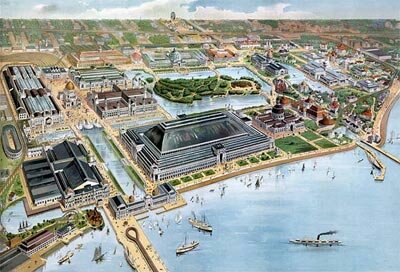
En route to Marrakech I finally began turning the pages of Erik Larson’s factual based bestseller, Devil in the White City: Murder, Magic, and Madness at the Fair that Changed America.
From Marrakech, the Pink City, to the White City… Eric Larson’s opus captures Chicago circa 1890’s during the building of an empire. An inside look at the nation’s leading architects developing the 1893 World’s Fair in record time amidst a turmoil marred process. While nearby a handsome doctor created his own fortune at the expense of others through swindling, murder and devious architecture.
The architecture of the World’s Fairs exuded grandeur and scale, eliciting awe and highlighting the march of progress whilst celebrating the accomplishments and ingenuity of humanity. The Chicago World’s Fair, a.k.a. the World’s Columbian Exposition, was no different. While spearheaded by Chicago based Burnham & Root, numerous architectural luminaries participated from Frederick Law Olmsted and Charles McKim to Richard Morris Hunt and Sophia Hayden Bennett, the first American woman to receive an architecture degree. It became known as the White City for its abundant use of white stucco and electrically lit promenades courtesy Tesla and Westinghouse.
The many architectural accomplishments of World’s Fairs exhibited a startling tendency to go up in flames. The wondrous Crystal Palace erected in London’s Hyde Park for the Great Exhibition in 1851 and duplicated two years later in what is now New York City’s Bryant Park both burnt down. The White City was likewise inflicted by arson.
Ultimately tradition called for these structures to be temporary. And so the architectural extravagance associated with these fairs have become somewhat forgotten in the modern collective consciousness, despite lingering examples. Actually prior to acquiring the book several years ago, my only familiarity with the exposition was an art catalog discovered in Tokyo highlighting Japan’s contribution to the Fair. It’s more commonly known that the Eiffel Tower was originally built as a temporary structure for the Paris 1889 show or the Unisphere by landscape architect Gilmore D. Clarke was originally created for the New York 1964/1965 World’s Fair. Chicago’s turn attracted over 27 million people and also offered its own symbolic structure. The world’s first Ferris Wheel by George Ferris, a railroad and bridge builder. Today, the London Eye (Millennium Wheel), Europe’s biggest Ferris Wheel, has become an integral feature in London’s urban fabric.
The White City…









